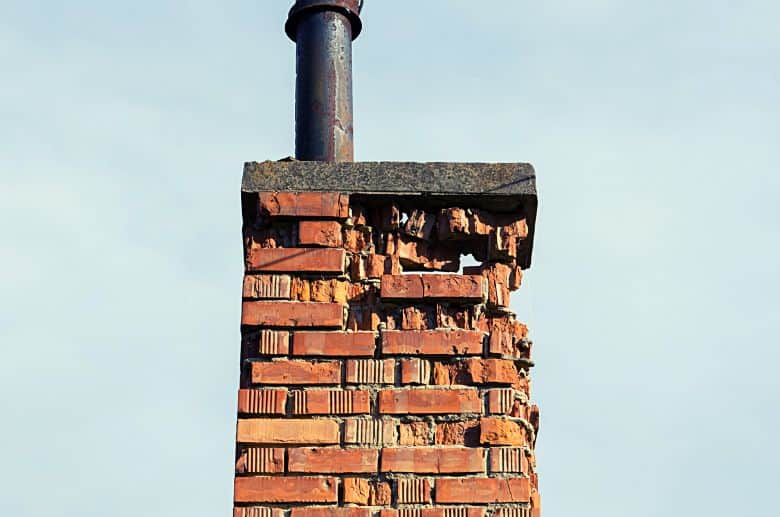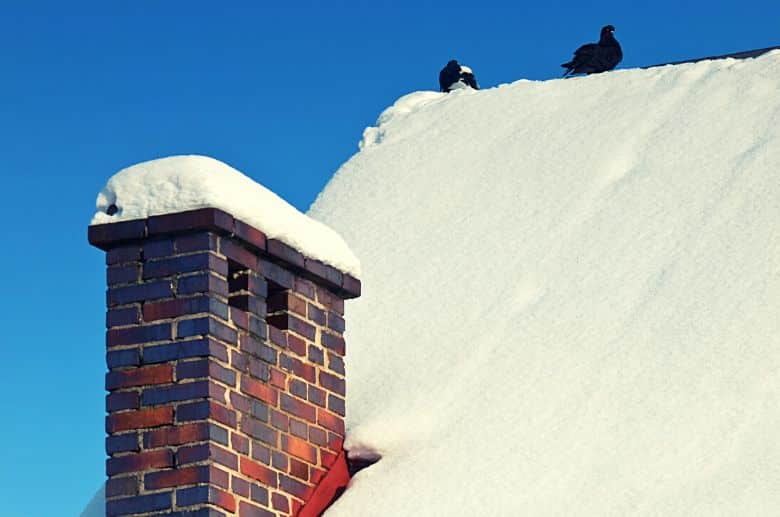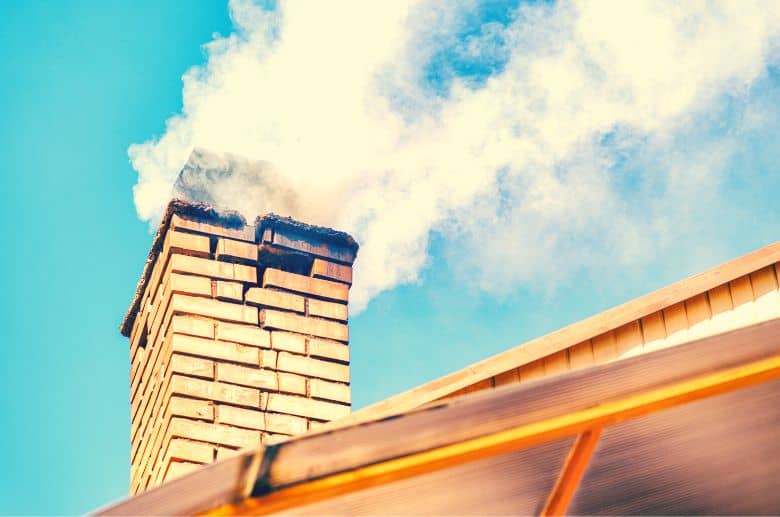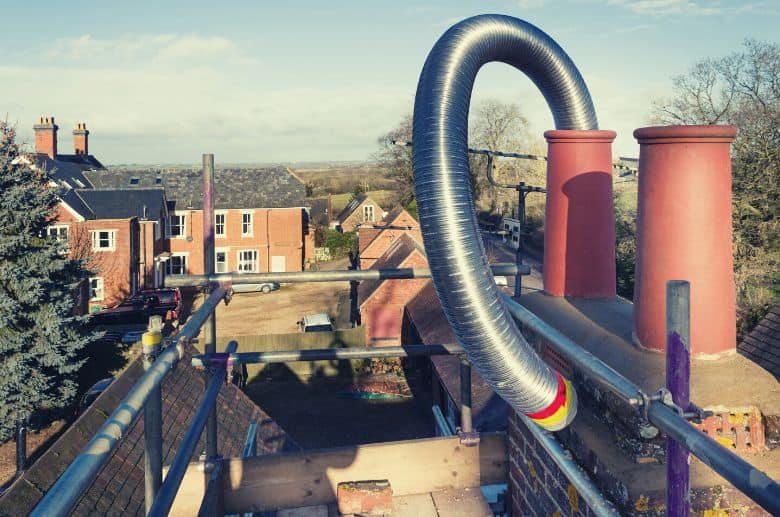Rebuilding a chimney can be difficult, so it’s essential to do it right to avoid costly mistakes.
Choosing whether to complete the rebuild or repair of the existing structure is among the most critical decisions for homeowners. Both options have pros and cons, and choosing the best for your home can be difficult.
The decision to restore or rebuild a chimney as a homeowner is not simple. However, the process can be much easier with the proper knowledge and the help of an experienced masonry contractor.
Here are some tips to help you decide to restore or rebuild your chimney.
What Causes Chimney Damage?

Various factors can cause chimney damage, and it’s essential to be aware of them so you can take steps to protect your chimney and avoid spending lots of money on costly repairs. To spell out the obvious, the weather is a massive factor in chimney damage.
And in the list below, you’ll see why:
Heavy Rain
The effects of heavy rain are often underestimated when it comes to chimney damage.
When water from heavy rain seeps into small cracks in your chimney, it can cause the structure to weaken and even collapse over time. Moreover, consistent heavy rain can also lead to mold and mildew, which can cause serious health problems.
Suppose you live in an area that experiences a lot of rainfall. In that case, it’s essential to have your chimney regularly inspected to fix any potential problems before they cause severe damage.
Snow
The freeze and thaw cycles that come with snow can cause chimney damage in two ways.
- First, when water seeps into the cracks of your chimney and freezes, it expands, causing those cracks to become more prominent.
- Second, as the snow on your roof melts, it can trickle down your chimney and refreeze at the bottom, forming an ice dam.
Ice dams can cause water to back up and seep into your home, leading to severe water damage.

Strong Wind
Strong winds can loosen the mortar and bricks, causing them to fall out or crack. They can also blow away the chimney cap or the shroud that covers the chimney, leading to water and debris getting into the chimney and causing damage.
If you live in an area prone to strong winds, it’s essential to have your chimney regularly inspected to ensure there are no significant damages.
Intense Heat
When bricks are exposed to extreme heat, they become dried out and brittle, which makes them more likely to break.
To prevent this from happening, it’s essential to have your chimney regularly inspected and repaired. A chimney liner can also help to protect your chimney from the intense heat by providing a barrier between the fire and the bricks.
This will help to ensure that your chimney can withstand the intense heat without sustaining any damage.
Signs Your Chimney Needs to be Rebuilt
While the factors above can cause damage, several signs indicate your chimney needs to be rebuilt.
Some of these signs include:
Efflorescence
Efflorescence is a white, powdery substance that appears on the surface of masonry chimneys.
This substance occurs when water seeps into bricks and mortar of your chimney and dissolves the minerals inside. As the water evaporates, it leaves behind this white, powdery substance.
While efflorescence itself isn’t harmful, it’s a sign that water is seeping into your chimney, which can lead to further damage down the road.
Damaged or Cracked Crown
The crown is the concrete slab that sits on your chimney, and its purpose is to protect bricks and mortar from water damage.
However, the crown can become cracked or damaged over time due to weathering, water damage, or heavy snowfall. A cracked or damaged crown can no longer protect your chimney, which allows water to seep in and cause further damage.
To prevent this from happening, it’s essential to have your chimney regularly inspected and repaired. This will help ensure that your crown is in good condition and prevents water from seeping in.
Leaning Chimney

A leaning chimney is a serious problem because it means that the structure of your chimney is compromised.
There are several reasons why a chimney might lean, but the most common is foundation settling. This occurs when the soil around your chimney shifts, causing the chimney to lean.
Another reason for a leaning chimney is that bricks and mortar have become weakened, which can cause the chimney to collapse.
If you notice your chimney leaning, it’s essential to have it inspected by a professional as soon as possible. They can determine the cause of the problem and make the necessary repairs.
——
Do You Need to Hire Chimney & Fireplace Expert?
Get free quotes from qualified experts near you. No commitment required!
——
Spalling Issues
Spalling refers to the process of the bricks flaking, chipping, or breaking away from the surface. When your chimney experiences spalling, it is vital to have a professional come and take a look as soon as possible.
Many things can cause spalling, but the most common reason is the expansion and contraction of the bricks due to temperature changes.
Spalling can also result from water damage. If there is water seeping into the bricks, it can cause them to break down over time.
If your chimney is spalling, you may notice the following:
- Small pieces of brick falling from the surface
- The surface of the brick is flaking
- There are cracks in the brick.
If you notice any of these signs, it is essential to have a professional look at them as soon as possible to determine the best solution for the problem.

Shaling Flue
Another problem you might have is when slices of flue tiles start collecting at the bottom of your chimney. This phenomenon is called shaling, which means that your flue tiling is damaged.
An intact flue liner is crucial because it’s the only way to operate a fireplace safely. Without it, the fire will be able to spread through the structure of your chimney, causing severe damage to your chimney and health and possibly leading to a fire.
This is because the liner protects the masonry from intense heat and prevents dangerous gases like carbon monoxide from seeping into your home.
A flue liner can become cracked or damaged over time, so it’s essential to inspect it regularly and repair or replace it as needed. There are several reasons your flue tiles might become damaged, but water damage is the most common.
If you notice shaling in your chimney, you need to have a professional come and take a look as soon as possible. They will be able to determine the cause of the problem and make the necessary repairs.
Damaged Mortar Joints

Over time, the mortar can become cracked or damaged, which can cause the bricks to
become loose. Water damage is the leading cause of damaged mortar joints, among other reasons.
If you find that your chimney’s masonry joints are worn, you should have a professional come out as soon as possible, and they can identify the source of the problem and make the necessary repairs.
Chimney Rebuilding Options
There are several chimney replacement options that every homeowner should know about. It’s also good to point out that every option depends on the severity of the damage.
Option 1: Partial Chimney Rebuilding
A partial chimney rebuilding is when professionals fix only the parts of the chimney that are broken or damaged and leave the rest alone. These parts may include the chimney crown, the chase cover, the flashing, and the mortar joints.
Partial chimney rebuilding is usually less expensive than a complete rebuild, and it can be a good option if the damage isn’t too bad.
Option 2: Full Chimney Rebuilding
If the damage to your chimney is more severe, a professional might recommend a full chimney rebuild. This is when they completely tear down the chimney and rebuild it from scratch.
A full chimney rebuild is usually more expensive than a partial rebuild, but it is necessary if the damage is significant.
With these two options in mind, every homeowner should know that chimney rebuilding is not a do-it-yourself job. It’s important to leave it to the professionals because they have the experience and knowledge necessary to do the job correctly.
Trying to rebuild a chimney on your own can result in further damage, which can be expensive.
How Long Does it Take to Rebuild a Chimney?
If the chimney is partially damaged, the rebuild might only take 1 to 4 days.
However, if the chimney is significantly damaged, it could take weeks or even months to rebuild. It’s important to note that the rebuilding process can be disruptive, so planning is essential.
If you are considering rebuilding your chimney, you should talk to a professional about your options and what you can expect. They can have a more accurate timeline for the rebuild.
Rebuilding a chimney Pros and Cons

As with any significant home improvement project, chimney rebuilding has pros and cons. Before deciding, it’s crucial to weigh the pros and cons carefully to determine if chimney rebuilding is proper for you.
Pros
- Can extend the life of your chimney
- Can improve the appearance of your chimney
- Can make your chimney safer to use
Cons
- Can be disruptive
- Can be expensive
At the end of the day, the decision to rebuild your chimney is up to you. If you are having problems with your chimney, it’s a good idea to call a professional for advice.
Chimney Rebuilding Alternatives Pros and Cons
Suppose you decide that chimney rebuilding is not the right option for you. In that case, you might be wondering what your alternatives are.
Here are a few chimney replacement options that you might want to consider:
Option 1: Chimney Liner

This is a stainless steel or aluminum sleeve that goes inside your chimney.
The liner can protect the chimney from further damage and make cleaning easier. It can also make your chimney more efficient since it can better keep the heat in.
However, installing a chimney liner is not a cheap option, and it can cost several thousand dollars, depending on the size of your chimney.
Option 2: Prefabricated Chimney
Prefabricated chimneys are usually made of wood or metal and come in various styles.
One advantage of prefabricated chimneys is that they can be easier to install than traditional ones. However, they can be more expensive, and it might be difficult to find one that matches the style of your home.
No matter your choice, it is essential to have your chimney inspected regularly. This will help to ensure that it is in good condition and working properly.
Pros of Chimney Rebuilding Alternatives
- It can be less expensive than rebuilding
- It can be easier to install
Cons of Chimney Rebuilding Alternatives
- It might not match the style of your home
- It might not be as durable as a rebuilt chimney
Before you decide to rebuild your chimney, be sure to explore all of your options. Weigh the pros and cons of each option to determine what is best for you.
How Do I Protect My Chimney and Keep it in Great Shape?
You can use several methods to protect your chimney and keep it functioning correctly. Here are a few tips for protecting your chimney:
Inspect Your Chimney Regularly
A professional should inspect your chimney at least once a year.
During the inspection, the professional will look for any damage signs and ensure that the chimney is clear of obstructions.
They will also clean the chimney if necessary. This will help to prevent build-up, which can lead to problems.
——
Do You Need to Hire Chimney & Fireplace Expert?
Get free quotes from qualified experts near you. No commitment required!
——
Use a Chimney Cap

A chimney cap is a cover that goes over the top of your chimney. It helps to keep out animals, birds, and debris and prevents rain and snow from getting into your chimney.
Chimney caps are relatively inexpensive and easy to install, and they can also help prolong your chimney’s life.
Make sure to get a cover that is the right size for your chimney. It should fit snugly so it doesn’t blow off in the wind.
Clean Your Chimney Regularly
It would be best if you also cleaned your chimney regularly, which will help to remove any build-up of soot and debris.
You can hire a professional or do this yourself if you have the right tools and knowledge. Either way, make sure to do it at least once a year.
Chimney Rebuilding Cost
The average cost to rebuild a chimney is between $1,000 and $5,000, or even higher, depending on the severity of the damage.
However, the cost will vary depending on the size of your chimney, the materials you use, and the type of rebuilding you require. If you’re considering chimney rebuilding, get multiple estimates to find the best price.
To help you, we’ve put together a guide below that covers the cost of chimney rebuilding in detail.
| Type of Rebuilding | Average Cost |
| Partial chimney rebuilding | Between $600 – $1,000 |
| Full chimney rebuilding | From $5,000 – $15,000 |
| Roofline-up chimney replacement | Ranges from $1,000 – $3,500 |
Conclusion
Replacing a chimney can be a big job, but ensuring it is in good condition is essential.
Weigh the pros and cons of each option to determine what is best for you. With some research and planning, you can ensure that your chimney is in good condition for years to come.






